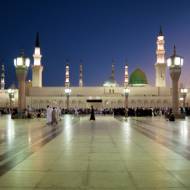

Prince Sultan bin Salman. (AP/Kamran Jebreili)
Saudi Arabia has plans to issue select visas to welcome tens of thousands of tourists a year as part of a sweeping national reform plan aimed at showcasing the country’s rich heritage, including pre-Islamic sites, and encouraging Saudis to spend some of their tourist money at home.
A day after Saudi Arabia outlined its Vision 2030 plan to wean itself from dependence on oil, a top Saudi prince told The Associated Press how the country plans to develop its tourism industry over the coming years.
Prince Sultan bin Salman, who is head of the Saudi Commission for Tourism and National Heritage and the oldest living son of King Salman, said that while the country will be opening up, it will not be “totally open for everybody to just show up and come in.”
“It is open for people that are doing business, for people working in Saudi Arabia, investing in Saudi Arabia, and people who are visiting for special purposes. And now it will be open for tourism again on a selected basis,” he said.
The religiously conservative country currently does not issue tourist visas, though it ran a pilot program between 2006 and 2010 welcoming around 25,000 visitors annually to see Saudi Arabia’s ancient archaeological sites and vast landscapes of mountains, coastline, valleys, volcanoes and deserts.
No date has been set for when tourist visas will be issued again.
Forging a Stronger Saudi National Identity
Though Saudi Arabia may seem an unlikely destination for a holiday, it boasts regions where Christian and Jewish communities once thrived, historic forts, a stunning Red Sea coastline and a diverse culture molded by ancient trade and pilgrimage routes.
Prince Sultan envisions a kingdom that also attracts big-spending Gulf nationals. Travelers from Saudi Arabia, Kuwait, Qatar, the United Arab Emirates, Bahrain and Oman are expected to spend $216 billion on world travel by 2030, according to a 2014 study for the travel tech company Amadeus. The study found that, on average, a traveler from these countries spends around $9,900 per trip outside the Gulf.
Promoting domestic tourism among Saudis is not just aimed at capturing some of that tourism money, but also at forging a stronger national identity among the country’s youth, hundreds of thousands of whom have studied abroad on scholarships and are active users of social media and the Internet.
“Smelling and hearing the sounds of their country and tasting this fantastic multicultural country is something that’s important for any nation that wants to go to the future confidently,” Prince Sultan said.
“So many people today may look at their country practically as an ATM machine, which is very, very, very sad,” he said, particularly as the country faces domestic and regional challenges. He said a lack of understanding about how the disparate tribes of Arabia became unified under his grandfather, the late King Abdelaziz, poses a major obstacle because the country needs “to have a Saudi citizen totally buying into their country’s history.”
Karen Young, a senior resident scholar at the Arab Gulf States Institute in Washington, said these initiatives are particularly important to the kingdom as sectarian tensions with rival Iran play out across the region.
“This notion of Saudi Arabia as center of the Arab world and really having ownership of not just Arab identity, but also Islamic identity. That’s a big goal,” she said.
The Vision 2030 plan approved by the Saudi Cabinet on Monday is a national blueprint for preparing the country for an era of lower oil prices, which have eroded the state’s ability to finance subsidies, wages and infrastructure projects.
Currently, 70 percent of Saudis work for the government. More than half of Saudis are under the age of 25, and millions will soon be looking for work and affordable housing.
Prince Sultan said tourism is one of the most promising industries for “creating real, meaningful, long-lasting jobs that Saudis like to do.”
The tourism commission’s figures show that around 245,000 Saudis work in the tourism sector. The target is to boost that to 352,000 by 2020 and to see investment in tourism upped by $8 billion to reach nearly $46 billion.
The prince said Saudi Arabia could have implemented many of the reforms outlined in the new roadmap when oil prices were above $100 a barrel and the kingdom’s finances were in surplus. He said ideas have been on the table for years for developing Saudi tourism sites and building museums to attract investors and visitors.
“Lost opportunities are the most dangerous thing to any economy, to any country. This transformation project has happened because we need to recover,” he said.
Though around 11 million Muslims from across the globe flock to Saudi Arabia annually to perform religious rites at holy sites in Mecca and Medina, the infrastructure for tourism outside these two cities remains nascent.
The prince said allowing pilgrims to stay on as tourists and creating an industry to support that would show visitors that Saudi Arabia “is moving forward” and that Islam did not emerge in a land void of history.
“The issue is very important to us, that people come and find a country that is stable, that is secure… to show off, if you like, our country,” he said.
By: AP

Subscribe to Our FREE Newsletter for More Great Stories Like This One
United with Israel publishes stories like this every day. We believe that our work allows a more balanced view of Israel to emerge. With so much anti-Israel media bias out there from outlets like CNN and the BBC, helping the Holy Land means getting our message out to as many people as possible.
You can help.
Subscribe to our free newsletter to ensure that you get the latest and best stories from United with Israel. Together we can make a difference, and it starts with communication.
Source: United with Israel

